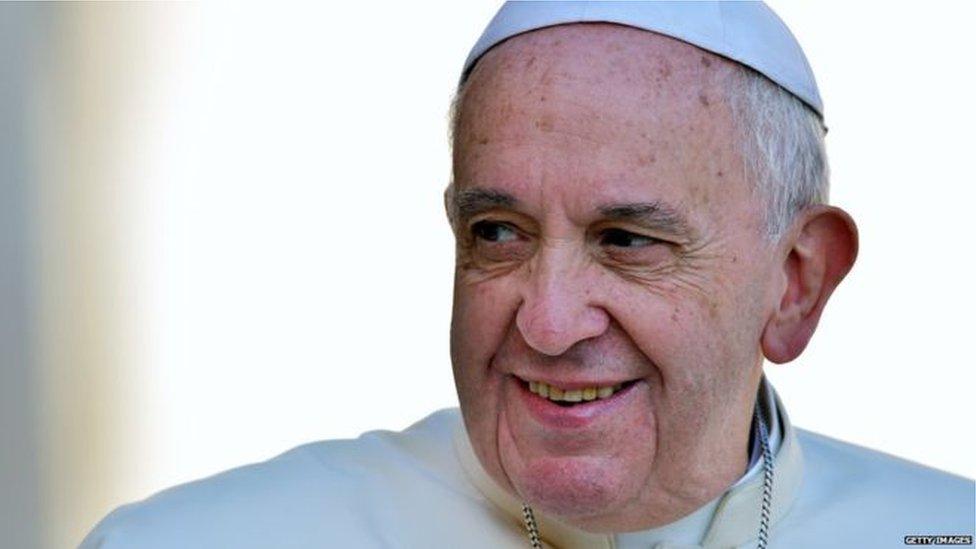Papal visit: Ireland's Catholic Church in graphs
- Published

The Catholic Church in Ireland is organised on an all-island basis
Pope Francis is coming to the Republic of Ireland in the wake of two referendums which illustrate a country moving away from its traditional Catholic roots.
Church and state were once deeply entwined in a nation that used to be among the most conservative in Europe.
Over the past three years, the Irish electorate has voted to legalise same-sex marriage and to end the constitutional ban on abortion.
But despite groundbreaking changes in social attitudes, official figures show the Republic of Ireland remains a predominantly Catholic country.
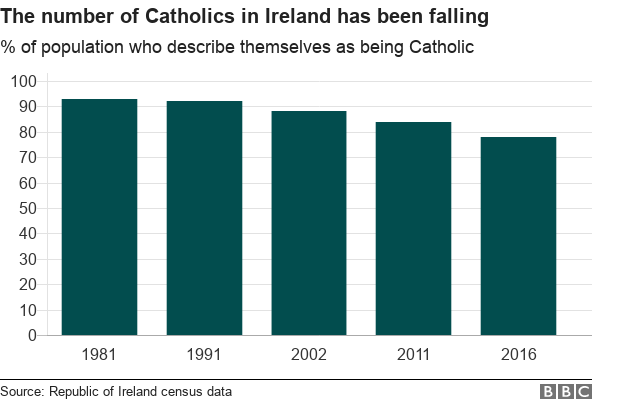
The latest census, carried out in 2016, showed that more than three quarters of the population describe themselves as Catholic.
The rate of attendances at religious services also remains relatively high in Ireland, at least when compared to other European nations with large Catholic populations.
One of the main problems for the Church, at present, is finding the manpower to minister to its flock.
A country that was once home to the largest seminary in the world, external, and which sent thousands of its missionaries around the globe, no longer has enough priests to staff all its parishes.
At present, the Catholic population in the Republic of Ireland stands at just over 3.7m people, according to the 2016 census, external.
However, the last four decades have seen a falling trend, in terms of the proportion of the population as a whole.

Maynooth is the largest seminary in Ireland
In 1981, two years after Pope John Paul II toured Ireland, Catholics accounted for 93% of the population.
The 1991 census, carried out shortly before the Church was engulfed in clerical abuse scandals, recorded little change at 92%.
But by 2011, the figure had fallen to 84% and over the next five years, there was a further decline.
The latest available statistic, from the 2016 census, puts the percentage of Catholics in Ireland at 78%.
The Irish Central Statistics Office (CSO) said that decline has been accompanied by a "corresponding rise in the number with no religion".
There are now more than 468,000 Irish residents who say they are not religious, equating to almost one tenth of the population.

The Republic of Ireland is still a predominantly Catholic country
The Catholic Church in Ireland is historically organised on an all-island basis, with some of its 26 dioceses and archdioceses stretching along both sides of the Irish border.
In Northern Ireland, the Catholic population is growing, especially among younger age groups.
Between Census Day 2001 and Census Day 2011, Northern Ireland's Catholic population increased by almost 80,000, external.
The census in 2011 stated that Catholics made up 45% of the population, while Protestants accounted for 48%.
But more recent figures, taken from the 2016 Labour Force Survey, showed that 44% of the working-age population are now Catholic while 40% are Protestant.

The older population is more likely to describe themselves as Catholic
The difference is even more marked among Northern Ireland's schoolchildren, where more than half (51%) are Catholic and 37% are Protestant.
Age is a particularly significant factor in religious demographics.
Data from the most recent European Social Survey (EES) showed that young people in the Republic of Ireland are three times more likely to say they have no religion than the oldest citizens of the state.
Just over 40% of 15-25 year olds who took part in the survey in 2016/17 said they were not religious, while only 13% of those aged over 85 had no faith.
However, among the remaining 60% of 15-25 years who said they are religious, the vast majority (87%) described themselves as Catholic.
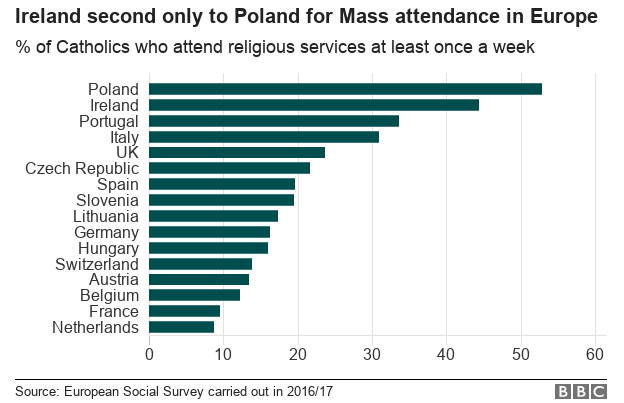
Although Mass attendances have fallen, they remain high compared to Europe
A generation ago, Sunday Mass was a regular feature of life in Ireland, while now many churches struggle to fill their pews on the Sabbath.
However, religious service attendance among younger Irish Catholics continues to be relatively high, perhaps not by traditional Irish standards, but certainly compared to their European peers,
St Mary's University, Twickenham, has analysed data from ESS surveys in 2014 and 2016, external, and found that almost a quarter of Irish Catholics aged 16-29 claim to attend church at least once a week.
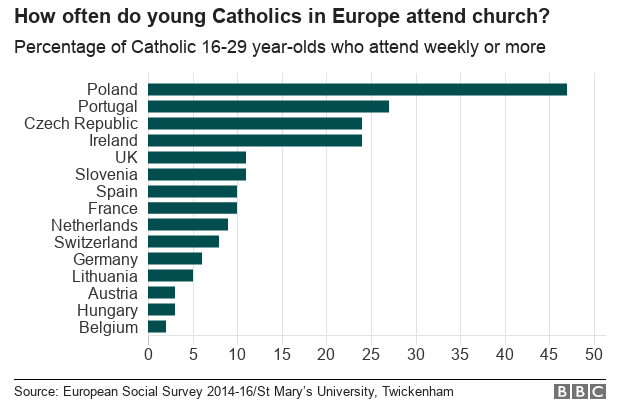
Young Catholics in Poland, native land of Pope John Paul II, top the list with 47% of them attending weekly Mass, followed by their Portuguese counterparts at 27%.
Looking at the wider population, fewer than half (44%) of Irish Catholic adults who took part in the 2016/17 ESS said they went to church at least once a week.
However, the figure still suggests that Irish respondents are more devout than those in other traditionally Catholic nations like Portugal, Italy and Spain.

The Pope in Ireland: Other stories you might like

Even if they are not regular Mass-goers, Irish Catholics still turn to the Church to mark significant occasions in their lives.
In 2016, there were just over 14,700 Catholic wedding ceremonies throughout Ireland, both north and south of the border, and more than 68,000 baptisms.
However, the figures are lower compared to 1979, when Ireland last hosted a papal visit.
Back then there were more than 82,700 baptisms and the number of weddings was 38% higher with almost 23,900 Catholic couples tying the knot.
Such celebrations still require a celebrant, and with few young men joining the ranks of the clergy, parish priests are in short supply.
Numbers halved
The 2018 Irish Catholic Directory states that there are more than 3,900 priests on the island, but that figure includes members of religious orders as well as clerics who are retired, sick or on study leave.
Church and state were once deeply entwined in the Republic of Ireland
Vocations have plummeted over the last 30 years, contributing to a rise in the average age of a priest which is now about 70.
Ireland's national seminary, St Patrick's College Maynooth, was home to more than 300 trainee priests when Pope John Paul visited the building in 1979.
Within 20 years, their numbers had more than halved.
Currently, there are just 35 seminarians studying in an institution that was designed to house more than 500 trainee priests.
Maynooth is not the only facility that trains Irish priests but it is soon to be the only one left on the island.
During the last academic year, there were 13 seminarians at the Irish College in Rome.
There were also three trainees at St Malachy's in Belfast, the only seminary in Northern Ireland, but it is due to close at the end of this year.
Dioceses which have been unable to replace retiring priests have asked their colleagues to take charge of more than one parish, and some parishes have been clustered into "pastoral areas" for the provision of Masses.
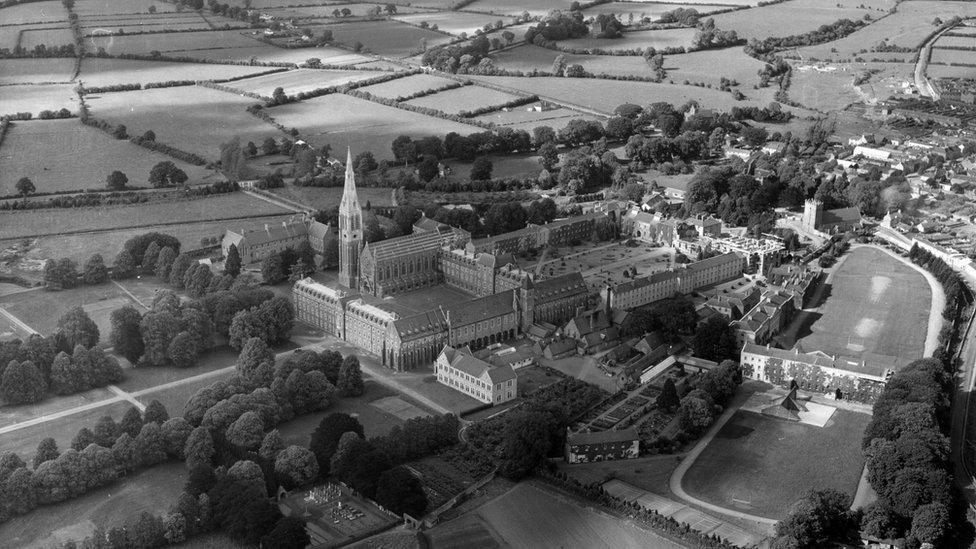
The seminary in Maynooth was designed to house 500 trainees priests (photo circa 1935)
Earlier this month, the Diocese of Clogher published a pastoral letter entitled "The Future Mission of Our Parishes" which outlined the "current reality in the diocese in terms of the diminishing number of priests and their increasing age profile".
"During the past year alone, the diocese has lost the service of seven priests through death, serious illness and other reasons," a diocesan statement said.
"While there was one new priest ordained, the letter makes it is clear that the number of active priests in our diocese will continue to decline."
The letter set out a "vision for a wide range of lay ministries" within the Diocese of Clogher and added that "great possibilities lie ahead".
Reduced Mass times
BBC News NI contacted each of the 26 dioceses to get a picture of how they are dealing with the demographic consequences of the drop in vocations.

The Catholic Church in Ireland is organised on an all-island basis
Each diocese was asked for their latest statistics on the numbers of active, retired, newly ordained and non-national priests, and whether they had to cut services due to a shortage of priests.
The figures show the parish staffing situation across the island is very mixed, with about half of the dioceses saying there has been no significant effect on services over the past five years.
However, the rest said they have either reduced or readjusted Mass times, or indicated that they are increasingly dependent on lay Catholics to take on more parish responsibilities.
Diocese of Anchonry
Has the diocese been forced to reduce services? "There may have been some re-adjustments but no significant loss in services provided."
Diocese of Ardagh and Clonmacnois
Has the diocese been forced to reduce services? "Four parishes have reduced the number of weekend Masses and added a Sunday evening Mass."
Archdiocese of Armagh
Has the archdiocese been forced to reduce services? "Yes."
Archdiocese of Cashel and Emly
Has the archdiocese been forced to reduce services? "Yes."
Diocese of Clogher
Has the diocese been forced to reduce services? "The Diocese of Clogher reviews the provision of pastoral ministry throughout the diocese on an ongoing basis in order to take account of various circumstances, including the availability of priests."
Diocese of Clonfert
Has the diocese been forced to reduce services? "No."
Diocese of Cloyne
Has the diocese been forced to reduce services? "No."
Diocese of Cork and Ross
Has the diocese been forced to reduce services? "Services have not been reduced in the last five years."
Diocese of Derry
Has the diocese been forced to reduce services? "There has not been any significant change in the number of Masses in the Diocese of Derry over the past five years."
Diocese of Down and Connor
Has the diocese been forced to reduce services? A spokesman said the times of services "are reviewed on an ongoing basis", but added that it is "difficult to attribute these changes to a shortage of priests". He said Down and Connor "continues to meet the needs" of all its parishes.
Diocese of Dromore
Has the diocese been forced to reduce services? A spokesman said services have been changed for a "wide range of reasons", including changing population trends, so it is not correct "to link this simply to a reduction in the number of priests".
Archdiocese of Dublin
Has the archdiocese been forced to reduce services? "There are enough priests for the celebration of Sunday Mass - however, the number of Masses has been reduced in some parishes."
Diocese of Elphin
Has the diocese been forced to reduce services? "Not significantly, thanks to the generosity of priests… Priests are experiencing greater pressure to meet pastoral needs and especially to find energy for new initiatives and challenges." *Elphin has a strong missionary tradition and its 35 diocesan priests are supported full-time by 28 non-diocesan priests.
Diocese of Ferns
Has the diocese been forced to reduce services? "Yes."
Diocese of Galway and Kilmacudagh
Has the diocese been forced to reduce services? "Mass schedules change for a variety of reasons, it is incorrect to characterize such changes as 'forced'.
Diocese of Kerry
Has the diocese been forced to reduce services? "Yes. We have six parishes without a resident priest." Their spokeswoman added that a "key priority is resourcing the laity to take up roles of responsibility".
Diocese of Kildare and Leighlin
Has the diocese been forced to reduce services? "Some parishes have rearranged Masses... but priests continue to do all the things they normally would with the assistance of the parish family."
Diocese of Killala
Has the diocese been forced to reduce services? "No."
Diocese of Killaloe
Has the diocese been forced to reduce services? "Yes."
Diocese of Kilmore
Has the diocese been forced to reduce services? "The number of priests has been reduced by up to half. Where once there were two priests ministering, now there is only one."
Diocese of Limerick
Has the diocese been forced to reduce services? "It is clear that with fewer priests [not as many] will be involved in various pastoral activities; there are however many lay people taking up new roles… In the last year more than 120 parish volunteers have been trained to lead public prayer."
Diocese of Meath
Has the diocese been forced to reduce services? A spokesman said: "There have been no considerable changes in general to provision of Masses, sacraments or pastoral services over the past five years." But they added that lay people are "playing a more active role".
Diocese of Ossory
Has the diocese been forced to reduce services? Their spokesman said Mass times have been adjusted in recent years and adds that it is "certainly true to say this also reflects the number of clergy".
Diocese of Raphoe
Has the diocese been forced to reduce services? "No."
Archdiocese of Tuam
Has the archdiocese been forced to reduce services? "Not necessarily, the restructuring was planned well in advance."
Diocese of Waterford and Lismore
Has the diocese been forced to reduce services? "There has been a small reduction in the number of scheduled Masses, particularly at weekends. There are no changes in relation to baptisms or marriages."
- Published20 August 2018

- Published20 August 2018
